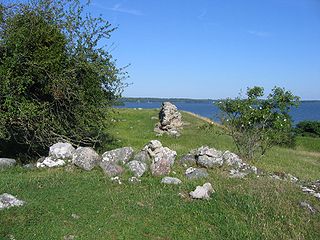
Year 1559 (MDLIX) was a common year starting on Sunday of the Julian calendar.
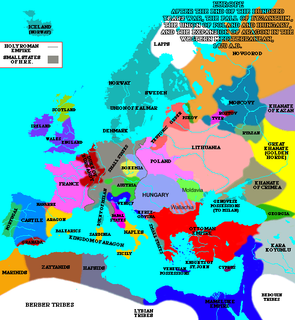
Year 1470 (MCDLXX) was a common year starting on Monday of the Julian calendar.

Charles XV & IV also Carl ; Swedish: Karl XV and Norwegian: Karl IV was King of Sweden and Norway from 1859 until his death. Though known as King Charles XV in Sweden, he was actually the ninth Swedish king by that name, as his predecessor Charles IX had adopted a numeral according to a fictitious history of Sweden.
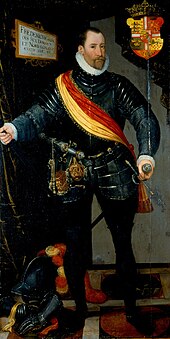
Frederick II was King of Denmark and Norway and Duke of Schleswig from 1559 until his death.

Gustaf V was King of Sweden from 1907 until his death in 1950. He was the eldest son of King Oscar II of Sweden and Sophia of Nassau, a half-sister of Adolphe, Grand Duke of Luxembourg. Reigning from the death of his father Oscar II in 1907 until his own death 43 years later, he holds the record of being the oldest monarch of Sweden and the third-longest reigning after Magnus IV and Carl XVI Gustaf. He was also the last Swedish monarch to exercise his royal prerogatives, which largely died with him, although formally abolished only with the remaking of the Swedish constitution in 1974. He was the first Swedish king since the High Middle Ages not to have a coronation and hence never wore a crown, a tradition continuing to date.

The Italian Wars, often referred to as the Great Wars of Italy and sometimes as the Habsburg–Valois Wars, were a series of Renaissance conflicts from 1494 to 1559 that involved most of the Italian states as well as France, the Holy Roman Empire, Spain, England and the Ottoman Empire.

The Treaty of Stolbovo is a peace treaty of 1617 that ended the Ingrian War which had been fought between Sweden and Russia between 1610 and 1617.

The Livonian War (1558–1583) was fought for control of Old Livonia, when the Tsardom of Russia faced a varying coalition of Denmark–Norway, the Kingdom of Sweden, and the Union of the Grand Duchy of Lithuania and the Kingdom of Poland.

The naval Battle of Colberger Heide took place on 1 July 1644 during the Torstenson War, off the coast of Schleswig-Holstein. The battle was indecisive, but a minor success for the Dano-Norwegian fleet commanded by Jørgen Vind, assisted by Grabow and King Christian IV, over a Swedish fleet commanded by Klas Fleming, assisted by Ulfsparre and Bjelkenstjerna.
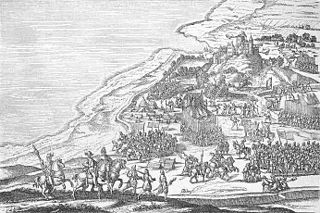
The Northern Seven Years' War was fought between the Kingdom of Sweden and a coalition of Denmark–Norway, Lübeck and Poland between 1563 and 1570. The war was motivated by the dissatisfaction of King Frederick II of Denmark with the dissolution of the Kalmar Union, and the will of King Eric XIV of Sweden to break Denmark's dominating position. The fighting continued until both armies had been exhausted, and many men died. The resulting Treaty of Stettin was a stalemate, with neither party gaining any new territory.

Daniel Rantzau was a Danish-German general. He was known for his leadership during the Northern Seven Years' War. For some years, he fought in Germany and Italy, and also took part in the Danish conquest of Dithmarschen in western Holstein during 1559. Rantzau also seems to have been a clear pro-war spokesman before the outbreak of the Northern Seven Years' War with Sweden in 1563.

NGC 1559 is a barred spiral galaxy in the constellation Reticulum. It is also a Seyfert galaxy. Although it was originally thought to be a member of the Dorado Group, subsequent observations have shown that it is in fact not a member of any galaxy group or cluster and does not have any nearby companions. NGC 1559 has massive spiral arms and strong star formation. It contains a small bar which is oriented nearly east-west and spans 40″. Its bar and disc are the source of very strong radio emissions.

Count Palatine Wolfgang of Zweibrücken was member of the Wittelsbach family of the Counts Palatine and Duke of Zweibrücken 1532–1559.
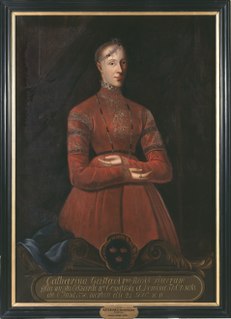
Catherine Vasa of Sweden was a Swedish princess, and the Countess consort of East Frisia as the spouse of Edzard II, Count of East Frisia. She was the oldest daughter of Gustav Vasa and Margareta Leijonhufvud. She was the autonomous Regent of Berum and Norden in Ostfriesland from 1599 to 1610.

Trollenäs Castle is a castle in Eslöv Municipality, Scania, in southern Sweden. It is known since the 14th century, and has been in the ownership of only two families, Thott and Trolle. The current building goes back to 1559 and was in the late 19th century renovated by architect Ferdinand Meldahl to resemble a French Renaissance castle.

Landskrona Citadel is situated in Landskrona, Scania, southern Sweden. Much of the original work is intact, and exaples remain of major parts of all the fortification, which is uncommon in such an accessible area. The moat around the central fortification is intact, as are the north-west and north-east parts of the most outer moat, which originally cooneced to a moat surrounding the city itself. centermost, the citadel sits on an island surrounded by its own moat. North of the fort, between the second, third and fourth moat is Sweden's oldest allotment-garden are. Several of its garden houses are attractions in themselves. Also the fortress castle itself hides both history as such as well as historical horrors, like the 16th Century dungeon in the old western tower, into which the unlucky prisoners were thrown down through a hatch. If surviving the 4-5 meter fall, there then was neither any daylight or any way out. Also the eastern tower has in later centuries served as a prison for lifetimers. And around 1900 until 1940 did a part of the fortress serve as a forced labour institution for vagrant women
Catherine of Brunswick-Wolfenbüttel was a member of the house of Welf and a Princess of Brunswick-Wolfenbüttel and by marriage Duchess of Saxe-Lauenburg.

Events from the year 1559 in Sweden

Events from the year 1638 in Sweden

Events from the year 1633 in Sweden
